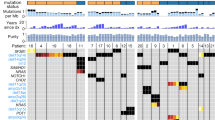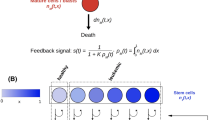Abstract
In this paper we firstly present three alternative formulations of a mathematical model for human tumour cell lines unperturbed by cancer therapy. The model counts the number density of cells in each phase of the cell cycle over time where cells are differentiated by their DNA content. Data are available from the Auckland Cancer Society Research Centre, Auckland, New Zealand, in the form of DNA histograms or profiles from 11 different human tumour cell lines (i.e. in vitro) unperturbed by cancer therapy. We then apply one (computationally fast) formulation of the model and discover that although in general different combinations of parameter values give rise to very different DNA profiles it is possible that different combinations of parameter values give rise to virtually identical profiles. Experimental estimates of the rate of transition from the G 1-phase (growth) to the S-phase (DNA synthesis) enable us to uniquely determine other model parameters of interest that give the least square error between the model and data. We finally apply our model to each of the 11 different cell lines and compare cell cycle phase transit times. Although the DNA histograms of each of the cell lines have similar shapes these cell lines have different combinations of transit times to each other, which could explain why they often react very differently when exposed to anti-cancer therapies during laboratory experiments. An understanding of the in vitro situation may give an insight into why some human cancer patients do not respond to cancer therapy.
Similar content being viewed by others
References
Arino, O., 1995. A survey of structured cell population dynamics. Acta Biotheor. 43, 3–25.
Arino, O., Axelrod, D., Kimmel, M. (Eds.), 1995. Mathematical Population Dynamics: Analysis of Heterogeneity. Carcinogenesis and Cell & Tumor Growth, vol. 2. Wuerz Publishing Ltd., Winnipeg, Canada.
Basse, B., Baguley, B.C., Marshall, E., Joseph, W.R., van Brunt, B., Wake, G.C., Wall, D.J.N., 2003. A mathematical model for analysis of the cell cycle in cell lines derived from human tumours. J. Math. Biol. 47, 295–312.
Basse, B., Baguley, B.C., Marshall, E., Joseph, W.R., van Brunt, B., Wake, G.C., Wall, D.J.N., 2004a. Modelling cell death in human tumour cell lines exposed to the anticancer drug paclitaxel. J. Math. Biol. 49, 329–357.
Basse, B., Baguley, B.C., Marshall, E., Wake, G.C., Wall, D.J.N., 2004b. Modelling cell population growth with applications to cancer therapy in human tumour cell lines. Prog. Biophys. Mol. Biol. 85, 353–368.
Basse, B., Wake, G.C., Wall, D.J.N., van Brunt, B., 2004c. On a cell growth model for plankton. Math. Med. Biol. J. IMA 21, 49–61.
Chiorino, G., Metz, J.A.J., Tomasoni, D., Ubezio, P., 2001. Desynchronization rate in cell populations: mathematical modeling and experimental data. J. Theor. Biol. 208, 185–199.
Diekmann, O., 1983. Growth, fission and the stable size distribution. J. Math. Biol. 18, 135–148.
Diekmann, O., Heijmans, H.J.A.M., Thieme, H.R., 1984. On the stability of the cell size distribution. J. Math. Biol. 19, 227–248.
Gyllenberg, M., Webb, G.F., 1990. A nonlinear structured population model of tumor growth with quiescence. J. Math. Biol. 28, 671–694.
Hannsgen, K.B., Tyson, J.J., 1985. Stability of the steady-state size distribution in a model of cell growth and division. J. Math. Biol. 22, 293–301.
McCluer, C., 2000. The many proofs and applications of Perron’s theorem. SIAM Rev. 42(3), 487–498.
Rossa, B., 1995. Asynchronous exponential growth in a size structured cell population with quiescent compartment. Carcinogenesis and Cell & Tumor Growth of Arino et al. (1995), vol. 2. pp. 183–200 (Chapter 14).
Takahashi, M., 1968. Theoretical basis for cell cycle analysis. II. Further studies on labelled mitosis wave method. J. Theor. Biol. 18, 195–209.
Ubezio, P., 1993. Relationship between flow cytometric data and kinetic parameters. Eur. J. Histochem. 37(Suppl. 4), 15–28.
Ubezio, P., 2004. Unraveling the complexity of cell cycle effects of anticancer drugs in cell populations. Discrete Contin. Dyn. Sys. Ser. B 4(1), 323–335.
Author information
Authors and Affiliations
Corresponding author
Additional information
An erratum to this article is available at http://dx.doi.org/10.1016/j.bulm.2005.06.001.
Rights and permissions
About this article
Cite this article
Basse, B., Baguley, B.C., Marshall, E.S. et al. Modelling the flow of cytometric data obtained from unperturbed human tumour cell lines: Parameter fitting and comparison. Bull. Math. Biol. 67, 815–830 (2005). https://doi.org/10.1016/j.bulm.2004.10.003
Received:
Accepted:
Issue Date:
DOI: https://doi.org/10.1016/j.bulm.2004.10.003




